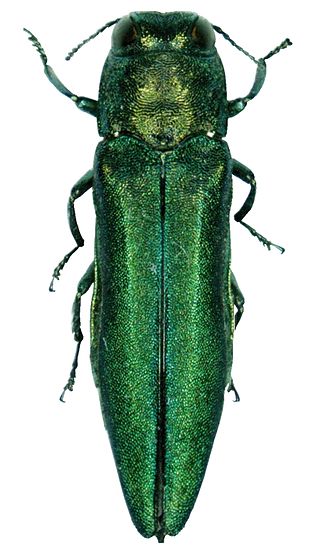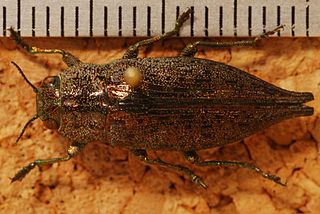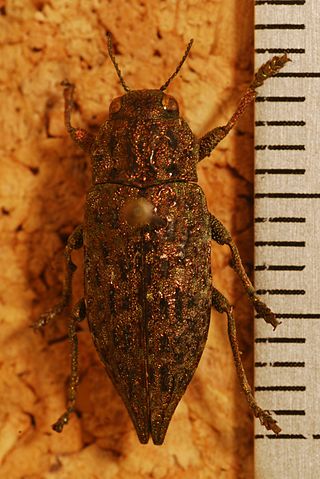
Bookworm is a general name for any insect that is said to bore through books.

Buprestidae is a family of beetles known as jewel beetles or metallic wood-boring beetles because of their glossy iridescent colors. Larvae of this family are known as flatheaded borers. The family is among the largest of the beetles, with some 15,500 species known in 775 genera. In addition, almost 100 fossil species have been described.

The emerald ash borer, also known by the acronym EAB, is a green buprestid or jewel beetle native to north-eastern Asia that feeds on ash species. Females lay eggs in bark crevices on ash trees, and larvae feed underneath the bark of ash trees to emerge as adults in one to two years. In its native range, it is typically found at low densities and does not cause significant damage to trees native to the area. Outside its native range, it is an invasive species and is highly destructive to ash trees native to Europe and North America. Before it was found in North America, very little was known about emerald ash borer in its native range; this has resulted in much of the research on its biology being focused in North America. Local governments in North America are attempting to control it by monitoring its spread, diversifying tree species, and through the use of insecticides and biological control.

Cleridae are a family of beetles of the superfamily Cleroidea. They are commonly known as checkered beetles. The family Cleridae has a worldwide distribution, and a variety of habitats and feeding preferences.

Carya laciniosa, the shellbark hickory, in the Juglandaceae or walnut family is also called kingnut, big, bottom, thick, or western shellbark, attesting to some of its characteristics. It is a slow-growing, long-lived tree, hard to transplant because of its long taproot, and subject to insect damage. The nuts, largest of all hickory nuts, are sweet and edible. Wildlife and people harvest most of them; those remaining produce seedling trees readily. The wood is hard, heavy, strong, and very flexible, making it a favored wood for tool handles. A specimen tree has been reported in Missouri with 117 cm (46 in) diameter at breast height, 36.9 m tall, and a spread of 22.6 m.

Carya tomentosa, commonly known as mockernut hickory, mockernut, white hickory, whiteheart hickory, hognut, bullnut, is a species of tree in the walnut family Juglandaceae. The most abundant of the hickories, and common in the eastern half of the United States, it is long lived, sometimes reaching the age of 500 years. A straight-growing hickory, a high percentage of its wood is used for products where strength, hardness, and flexibility are needed. The wood makes excellent fuel wood, as well. The leaves turn yellow in Autumn.

Cryptolaemus montrouzieri, common name mealybug ladybird or mealybug destroyer, is a species of ladybird beetle native to eastern Australia. The beetle feeds on mealybugs and other scale insects, and is used to control those pests on citrus orchards worldwide.

Chiasognathus grantii is a species of stag beetle found in Argentina and Chile. It is known as Darwin's beetle, Grant's stag beetle, or the Chilean stag beetle.

The cottonwood borer is a species of longhorn beetle found in the United States east of the Rocky Mountains that feeds on cottonwood trees. It is one of the largest insects in North America, with lengths reaching 40 millimetres (1.6 in) and widths, 12 mm (0.47 in). It is the only species in the genus Plectrodera.

Alaus oculatus, commonly called the eastern eyed click beetle or eyed elater, is a species of click beetle.

Zigrasimecia is an extinct genus of ants which existed in the Cretaceous period approximately 98 million years ago. The first specimens were collected from Burmese amber in Kachin State, 100 kilometres (62 mi) west of Myitkyina town in Myanmar. In 2013, palaeoentomologists Phillip Barden and David Grimaldi published a paper describing and naming Zigrasimecia tonsora. They described a dealate female with unusual features, notably the highly specialized mandibles. Other features include large ocelli, short scapes, 12 antennomeres, small eyes, and a clypeal margin that has a row of peg-like denticles. The genus Zigrasimecia was originally incertae sedis within Formicidae until a second species, Zigrasimecia ferox, was described in 2014, leading to its placement in the subfamily Sphecomyrminae. Later, it was considered to belong to the distinct subfamily Zigrasimeciinae.
Dicerca pectorosa is a species of beetle from the family Buprestidae first described by John Lawrence LeConte in 1857. It can be found in North America from British Columbia, Southern Alberta and Saskatchewan, as well as south to California and Montana. It feeds on various Prunus species.

Dicerca lurida is a species of black coloured beetle from Chrysochroinae subfamily which is 12–20 millimetres (0.47–0.79 in) long and is known for feeding on various hickory species. The species fly from April to May during which they also sunning on tree trunks and logs. The life stage of the species is at least three years.

Dicerca divaricata, also known as the flatheaded hardwood borer, is a species of black coloured beetle from subfamily Chrysochroinae found in North America. It is 15–22 millimetres (0.59–0.87 in) long. The species is known for feeding on various maples such as Acer saccharum and Acer rubrum as well as Ulmus americana and Cercis species. The species fly in May and June.
Dicerca pugionata, also known as the witch-hazel borer, is a species of buprestid beetle from the Chrysochroinae subfamily that occurs in the Eastern North America. Its food includes witch-hazel species including Hamamelis virginiana in mid July. It also feeds on ninebark and alder species.
Dicerca lugubris is a species of beetle from the subfamily Chrysochroinae first described by John Lawrence LeConte in 1860. It is dark-cupreous coloured on top and black-cupreous below. The length of the species may vary from 11.1–16.5 millimetres (0.44–0.65 in) while they can be as wide as 4.1–6.0 millimetres (0.16–0.24 in). The species can be found on Lake Superior, Marquette, Michigan as well as Laniel, Quebec. It is also found in Iowa, Alberta, and southeastern North America where it feeds on jack pine.
Phaenops californica, the California flatheaded borer, is a species of metallic wood-boring beetle in the family Buprestidae. It is found in Central America and North America.

Dicerca tenebrosa, the flatheaded conifer borer, is a species of metallic wood-boring beetle in the family Buprestidae. It is found in North America.

Oemona hirta, the lemon tree borer, also known as the whistling beetle or the singing beetle, is a longhorn beetle endemic to New Zealand. Its larvae are generalist feeders, boring into the wood of a wide variety of trees, native and introduced. When citrus orchards were first established in New Zealand, this beetle started inflicting serious damage, and so gained the name "lemon tree borer". Four species within the genus Oemona have been identified, suggesting that more species could be found. When disturbed by predators or humans, the adult beetle stridulates creating a "rasp" or "squeak" sound by rubbing its thorax and head together against an area of thin ridges. Māori would eat a liquid called "pia manuka", which was produced by manuka trees when its wood was damaged by the larvae. When Captain Cook first arrived in NZ, his naturalists, Banks and Solander, collected a lemon tree borer in their first collection between 1769 and 1771. This oldest collected specimen can be found in the British Museum. A few years after the first collection, the species would be first described by the Danish naturalist Fabricius in 1775.

Microrestes robustus is a stick insect species native to northwestern Vietnam.















